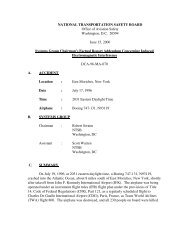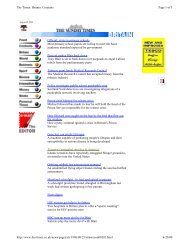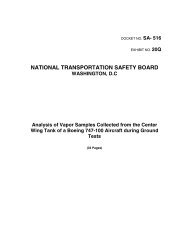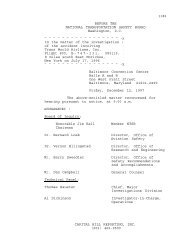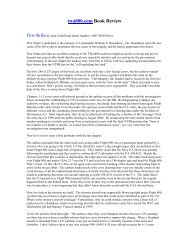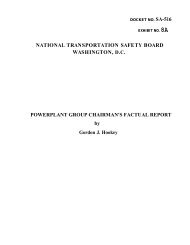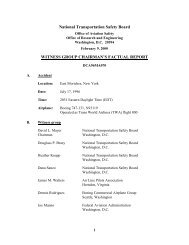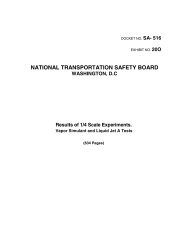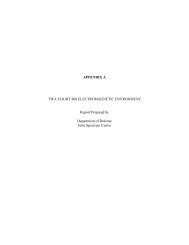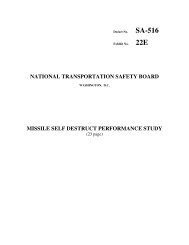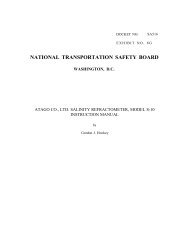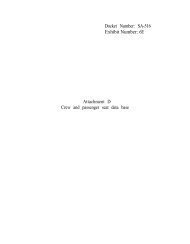Exhibit No. 11A - Group Chairman Factual Report - TWA Flight 800 ...
Exhibit No. 11A - Group Chairman Factual Report - TWA Flight 800 ...
Exhibit No. 11A - Group Chairman Factual Report - TWA Flight 800 ...
Create successful ePaper yourself
Turn your PDF publications into a flip-book with our unique Google optimized e-Paper software.
According to the Minimum Equipment and Dispatch Procedures Manual, one jettison pump maybeinoperative, provided the takeoff weight does not exceed performance limitations determined by theengine-out maximum landing weight, the jettison nozzle remains closed, and the <strong>No</strong>. 1 and <strong>No</strong>. 4 maintank jettison transfer valves remain closed.A center wing jettison valve may be inoperative in the open position, provided that both jettison nozzlevalves operate normally and are closed. A center wing jettison valve maybe inoperative in the closedposition provided that the center tank fuel is considered as payload and all of the number 2 and 3 boostpumps operate normally.Number 1 and/or number 4 main tank jettison transfer valves maybe inoperative in the closedposition, provided fuel required to be jettisoned does not deplete the inboard main tanks below thequantity in the outboard main tanks plus 1 and 4 reserve tanks.The <strong>TWA</strong> Kansas City, MO, Maintenance Coordinator must approve the deferral of an inoperativejettison valve, and the fuel jettison switch cover (F/E panel) must be placarded “INOP.”MAINTENANCE HISTORY OF FUEL PUMPS INSTALLED ON N93119The maintenance history for each fuel pump is identified by <strong>TWA</strong> Component Shop Records. Eachrecord identifies the aircraft and date the pump was previously removed from. The discrepancy isrecorded, along with the work accomplished. The pump is then tested, signed off, and dated asserviceableThe following text identifies the previous pumps that were installed on N93119 and the reason forremoval, along with the most recent reason for removal, and the work accomplished on the pump that wascurrently installed onN93119 at the time of the accident1. Scavenge Pump - Serial number M285, was removed from N93119 on August 15, 1994, due to thepump being inoperative. During the overhaul, it was found that the bearings were worn, causing the rotorto rub, The stators, bearings, blades, valve housing liner and rotor were replaced, The pump was signedoffas overhauled on October 18, 1994, and tested on October 20, 1994. The pump was re-installed inN93 119 on April 22, 1996.2. APU DC Pump - Serial number M365, was removed from N133TW on April 2, 1990, as the pump wasinoperative. During the overhaul, it was found that the brushes were worn, and the rotor was damaged.The pump was signed-off as repaired on September 6, 1990, and tested on September 12, 1990. Thepump was installed in N93119 on April 15, 1996.3. Boost Pump - Serial number 711533, located in the left wing was installed new inN93119 onDecember 20, 1976. The pump remained operational, and there is no record of repair or overhaul.4. Boost Pump - Serial number 6<strong>800</strong>03, located in the left wing, was removed from N93105 onSeptember 16, 1993, due to an open fuse. The pump was repaired by replacing the fuse, rotor andpacking. The pump was signed-off as repaired on December 15, 1993, and tested on December 27, 1993.The pump was installed in N93119 on February 22, 1994.5. Boost Pump - Serial number 95309A located in the left wing, was removed from N134TW onDecember 23, 1991, due to the pump being inoperative. During the repair, it was found that the statorwas burned. The pump was signed-off as repaired and tested on March 2, 1992. The pump was installedin N93119, on March 13, 1992.14





